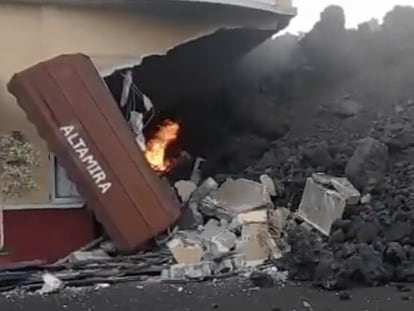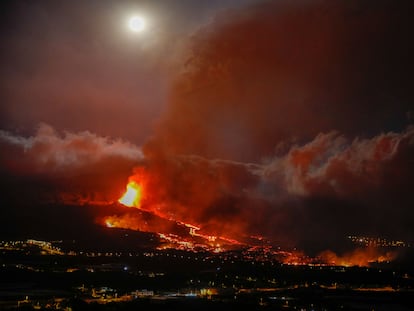Despite diversion efforts, wall of lava reaches more homes in La Palma
A cloud of sulfur dioxide is expected to reach mainland Spain on Wednesday afternoon and gradually cover the entire Iberian peninsula on Thursday and Friday, according to the EU Copernicus program
Experts monitoring the eruption of a volcano on the Spanish island of La Palma, in the Atlantic Ocean, now believe the rivers of lava flowing down from the Cumbre Vieja ridge may not reach the sea after all. These towering lava flows, some of them 12 meters high, have been slowing down since they first began to descend the mountainside on Sunday.
Satellite images show that the rivers of molten rock have already engulfed around 154 hectares of land and destroyed 320 homes. The advancing lava has also forced the evacuation of 6,000 people in this popular tourist destination in Spain’s Canary Islands, off the northwestern coast of Africa.
Firefighters sent in from Gran Canaria on Tuesday attempted to redirect the lava away from homes in the neighborhood of Todoque, in the town of Los Llanos, by flattening the earth along its path with heavy machinery. The hope was that the lava would take the easy way and head toward a ravine without swallowing up buildings. “We had to at least try,” said one firefighter as the wall of lava inched ever closer on Wednesday morning.
But by the afternoon the molten rock had already penetrated several parts of the neighborhood, where residents were given one hour to return to their homes on Tuesday to collect essential items. Island authorities have extended this deadline to 9pm on Wednesday.
A cloud of sulfur dioxide is expected to reach mainland Spain on Wednesday afternoon and gradually cover the entire Iberian peninsula on Thursday and Friday, according to the European Space Agency’s Copernicus program.
Pablo Casado, leader of the main opposition Popular Party (PP), asked the government to approve a disaster declaration for the area. “What we are seeing is not a wonderful show, it is a catastrophe,” he said on Wednesday.

The volcano’s behavior so far, together with the area’s history, suggest that for weeks to come there will continue to be an effusive rather than explosive eruption – that is, when magma flows out of the vent and oozes down the mountainside as lava, without sending rocks, ash or gas high in the air. But experts noted that it is difficult to predict how the lava will act in the coming hours, because when the surface in contact with the air cools down and solidifies, the flow is diverted in different directions.
“It is possible that [the lava] will reach the sea if there is enough emission, but the lava flows have been cooling down for two days now,” said Raúl Pérez, a geologist, seismologist and researcher at the Geological and Mining Institute of Spain (IGME), and a member of the team monitoring the eruption of Cabeza de Vaca in La Palma. “It might reach it or it might not. We’re talking about a fluid with very complex mechanics.”
A scientific committee monitoring the eruption has measured the progress of the lava flow, which is now advancing 200 meters every hour. If it does come into contact with the seawater, it is expected to release a large amount of gases and potentially trigger explosions. This temporary pollution would alter the temperature and acidity of the water, reduce the concentration of oxygen and increase levels of CO2 and other metals.
On midmorning on Wednesday, the lava front was 2.5 kilometers away from the coast in a straight line, according to satellite images captured by Copernicus The surface area covered by the lava flow had increased by 50% in 12 hours.
The regional premier of the Canary Islands, Ángel Víctor Torres, said on Wednesday that no more evacuations have taken place in recent hours and that evacuees are being put up in military facilities, hotels and apartments. For them, a return to their normal lives will not be possible as soon as the eruption ends, as many conditions will have to be met regarding the safety of buildings and the surrounding land.
A peak of energy on Tuesday
Volcanologists reported that on Tuesday night the volcano’s energy reached a peak that was reflected in the seismic signals, and that magma was spewed out with greater force, reaching heights of 400 meters. By 8pm the ground in the eruption area had experienced an uplift of nearly 30 centimeters. Also around the same time, the vent of the volcano’s main cone opened up and partially collapsed.
On Wednesday morning, however, the tremor signals had become considerably weaker. At that point, lava was flowing out of four vents on the volcano: three in the original area and one more that opened up later in Tacande.
English version by Susana Urra.
Tu suscripción se está usando en otro dispositivo
¿Quieres añadir otro usuario a tu suscripción?
Si continúas leyendo en este dispositivo, no se podrá leer en el otro.
FlechaTu suscripción se está usando en otro dispositivo y solo puedes acceder a EL PAÍS desde un dispositivo a la vez.
Si quieres compartir tu cuenta, cambia tu suscripción a la modalidad Premium, así podrás añadir otro usuario. Cada uno accederá con su propia cuenta de email, lo que os permitirá personalizar vuestra experiencia en EL PAÍS.
¿Tienes una suscripción de empresa? Accede aquí para contratar más cuentas.
En el caso de no saber quién está usando tu cuenta, te recomendamos cambiar tu contraseña aquí.
Si decides continuar compartiendo tu cuenta, este mensaje se mostrará en tu dispositivo y en el de la otra persona que está usando tu cuenta de forma indefinida, afectando a tu experiencia de lectura. Puedes consultar aquí los términos y condiciones de la suscripción digital.
More information
Últimas noticias
Maduro pleads not guilty before the federal court in New York: ‘I am still the president of Venezuela’
A new test can detect Alzheimer’s from a finger prick
UN team enters Sudanese city of El Fasher after paramilitary massacre: ‘It’s like a ghost town’
A recipe for resistance: Indigenous peoples politicize their struggles from the kitchen
Most viewed
- Gilles Lipovetsky: ‘If you want to live better and fall in love, take Prozac, don’t look to philosophy’
- Alain Aspect, Nobel laureate in physics: ‘Einstein was so smart that he would have had to recognize quantum entanglement’
- Alvin Hellerstein, a 92-year-old judge appointed by Bill Clinton, to preside over Maduro’s trial in New York
- Why oil has been at the center of Venezuela-US conflicts for decades
- Maduro’s downfall puts China’s relationship with Venezuela to the test











































